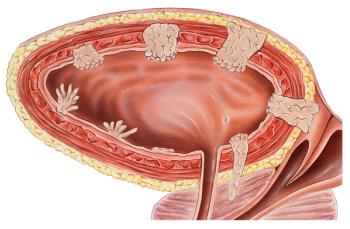
New Genomic Test Improves Lung Cancer Diagnostics
A prospective study found that a bronchial airway gene-expression classifier improved the diagnostic performance of bronchoscopy for lung cancer detection.
A prospective study found that a bronchial airway gene-expression classifier improved the diagnostic performance of bronchoscopy for the detection of lung cancer. The use of the classifier could help avoid further invasive testing in lower risk individuals.
Approximately 500,000 bronchoscopic examinations occur each year in the United States, half of which are done for evaluation of suspected lung cancer. “However, bronchoscopy is limited by its sensitivity, which ranges from 34% to 88%, depending on the location and size of the lesion,” wrote study authors led by Avrum Spira, MD, of Boston University School of Medicine, who coinvented the genomic test. “Patients with a nondiagnostic bronchoscopic examination often undergo further invasive testing.” This often takes place in patients ultimately found to have benign lesions.
In the new study, researchers set out to validate a gene-expression classifier in bronchial epithelial cells. This involved two separate cohorts of current or former smokers undergoing bronchoscopy for suspected lung cancer, known as AEGIS-1 (298 patients) and AEGIS-2 (341 patients). Results were
The prevalence of lung cancer in the two cohorts was 74% and 78%, respectively. A combined total of 43% of bronchoscopies were nondiagnostic; 35% of patients with benign lesions underwent invasive procedures after bronchoscopy.
In the AEGIS-1 cohort, the area under the curve for the gene-expression classifier was 0.78, with a sensitivity of 88% and a specificity of 47%; the test correctly identified 194 of 220 patients with cancer, and 37 of 78 without cancer. Results were similar in AEGIS-2, with an AUC of 0.74, a sensitivity of 89% (237 of 267 patients with cancer), and a specificity of 47% (35 of 74 patients without cancer).
Combining the classifier and bronchoscopy yielded a sensitivity of 96% in AEGIS-1 and 98% in AEGIS-2; this was independent of lesion size and location.
In 101 patients with an “intermediate” pre-test probability for cancer, bronchoscopy was nondiagnostic in 83%. The gene-expression classifier in this group had a negative predictive value of 91% and a positive predictive value of 40%.
“These data suggest that the bronchial genomic classifier enables physicians to confidently identify patients who are at low probability for having lung cancer following an indeterminate bronchoscopy result,” Spira said in a
Newsletter
Stay up to date on recent advances in the multidisciplinary approach to cancer.


























































































